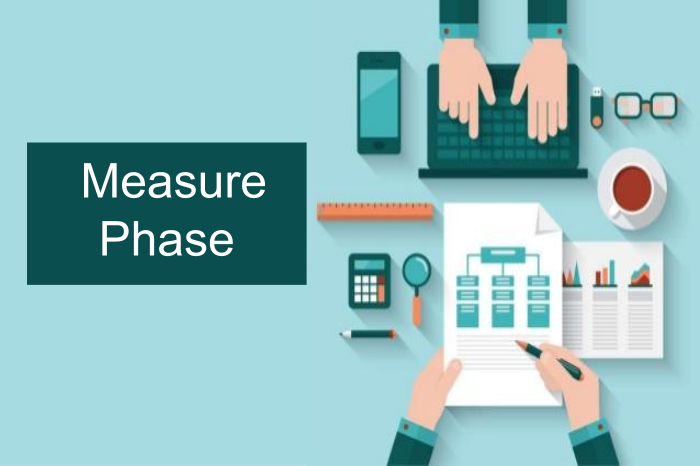Measure
The 2nd phase of a DMAIC Process:
The MEASURE phase includes more statistical studies and data analysis than the DEFINE phase. This phase focuses on measurement system validation and gathering root causes. Statistical approach of this phase makes it vital for the DMAIC project.

The Voice of the Process (VOP) has variation from both the measurement system and the process and all its families (sources) of variation. The MSA will quantify the amount of variation found in the data that is induced from the measurement system.The next phase, ANALYZE, uses statistical tests to quantify the variation due to the inputs only (separate from the MSA variation). Many projects stall at this phase; conducting a MSA can be an exhaustive effort.
As a GB/BB, organize to secure down and test your knowledge of basic statistics. Many measurement systems need work or can be improved with simple action; others will require much more and can become a project all by itself. In this phase, the problem statement and project contract are commonly refined as a result of forming an accurate baseline for the metrics being targeted. Without being able to measure, it is impossible to quantify change, what gets measured usually gets improved.
Measure phase will most likely introduce statistical software, and this alone can be time-consuming to get at ease with. It is suggested that you familiarise yourself with the statistical software package before starting a project
Data Collection:
Structures with documentation of data often have flaws, or the data needed only occurs infrequently. Data collection takes time from operators and management and can be viewed as a liability. Finding the balance to get as much information as possible that is proven trustworthy while not consuming unnecessary resources is the key to success in this phase.
This data collection will often come across opposition and can lead to gatherings taking the easier route and rounding off numbers, or otherwise skewing and creating inaccuracies. Education, awareness, rule setting, and up front discussion with all stakeholders (not just team members) is ideal to get the most teamwork and validity in data collection.
Without taking away from the status, often teams cruise through the DEFINE phase then find out that data collection and analysis are very time-consuming and challenging.
Key Features of Measure Phase:
- Map process and identify inputs and outputs.
- Cause and effect matrix.
- Established measurement system capability.
- Establish Process capability baseline.
Why do we Measure?
- To thoroughly understand the current state of our process and collect reliable data on process inputs that you will use to expose the underlying causes of problems.
- To know “where you are.”- the extent of the problem.
- To understand and quantify the critical inputs (Xs) that we believe (theories) are contributing to our problems.
Key Tools of Measure Phase:
- X-Functional process map
- Total product cycle time
- Fishbone analysis
- FEMA (Failure Mode and Effect Analysis)
- Control charts
- Statistical analysis, and Pareto charts
Steps involved in Measure Phase:
- CTQ characteristics
- Performance standards
- Data collection
- Validate measurement system
Why Process Mapping?
Process Mapping
- Visually represents the work we process.
- Identifies the problem areas and opportunities for process improvement.
- Provides the common understanding of the entire process and specific roles and contributions of process participants.
- Before you can improve a process, you must understand it Process Maps are good for Streamlining work activities and telling new people, as well as internal and external customers, “What we do around here.”
- Helping in the efforts to ease cycle time, avoid redraft, remove some assessments, and prevent errors.Process Maps are a great problem-solving tool. Helps us to determine what is the problem / what it is not.
Calculating the Current Sigma Level:
Measure phase also includes collecting the measures that the current process has. This includes measuring the defects per million. Once the defects per million are calculated, the current Sigma Level of the process is found out. This gives the team an idea of the effort that may be required out of them.
Considerations:
Dependent of the specific procedure, you are examining and the resources available, you may be able to work on gathering baseline data and creating a process map altogether, or you may aim to complete one task before beginning the other. Keep in mind however that once you analyse your data, you may get a better idea of which part of the process is the problem causing. On the other hand, once you have an understanding of the steps and variation in your process, you may better understand what data you need to collect to establish baseline performance. So flexibility in scheduling these tasks is to your advantage.
